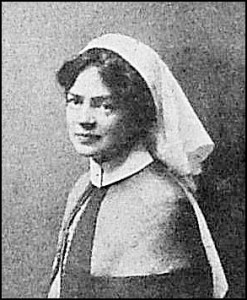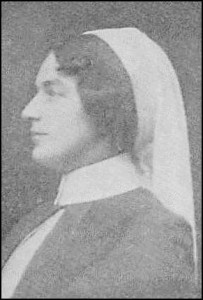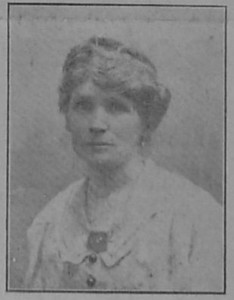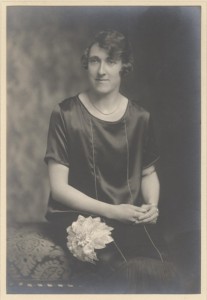With over four military hospitals in the town during the War many local women worked as either trained nurses or as VAD Nurses. Local nurses also served in some of the war zones and on hospital ships. Here are some of their stories.
Sister Ethel Bray (Queen Alexandra’s Imperial Military Nursing Service or QAIMNS)
 Ethel lived in Buckhurst Road, Bexhill with her sisters, Evelyn and Mary, who were also nurses and her brother John who served during the First World War. She was a trained nurse who immediately volunteered to support the war effort in 1914. She was a Sister in Out- Patients in Hampstead General Hospital and a trained Masseuse by 1912. In December 1914, aged 36, Ethel joined the hospital ship Asturias which evaded attack by a German submarine whilst bringing wounded soldiers back from France. Ethel reported the, “Torpedo was not 3 feet away from us”. On Hospital Ship Nevasa she served in the Dardanelles and was mentioned in dispatches “for exceptional service and devotion to duty”. She returned in 1916 to Colchester Military Hospital and successfully ran a Military Hospital in Ipswich. After the war between 1929-1937 Ethel was the Nursing Sister aboard P&O liner Narkuna.
Ethel lived in Buckhurst Road, Bexhill with her sisters, Evelyn and Mary, who were also nurses and her brother John who served during the First World War. She was a trained nurse who immediately volunteered to support the war effort in 1914. She was a Sister in Out- Patients in Hampstead General Hospital and a trained Masseuse by 1912. In December 1914, aged 36, Ethel joined the hospital ship Asturias which evaded attack by a German submarine whilst bringing wounded soldiers back from France. Ethel reported the, “Torpedo was not 3 feet away from us”. On Hospital Ship Nevasa she served in the Dardanelles and was mentioned in dispatches “for exceptional service and devotion to duty”. She returned in 1916 to Colchester Military Hospital and successfully ran a Military Hospital in Ipswich. After the war between 1929-1937 Ethel was the Nursing Sister aboard P&O liner Narkuna.
For more information N0001 BRAY Ethel (Sister)
Sister Cicely Evelyn Bray (Queen Alexandra’s Imperial Military Nursing Service or QAIMNS)
 Cicely Evelyn also lived at Buckhurst Road, Bexhill and like her sister she was a qualified nurse who volunteered for war work as soon as war began in 1914. She was posted to the Royal Herbert Hospital, Woolwich in April 1914 aged 29. By 1916 she was reported to be in charge of the operating theatre and was awarded the Royal Red Cross Medal. In November 1916 she embarked for a field hospital in France near the front lines and in October 1917 she was posted to a casualty clearing station where she was reported to be Acting Assistant Matron. By May 1918 she was Sister-in-charge of the Surgical Hut of a hospital in Rouen where she also met Col. A.G.R. Garrod M.C., D.F.C., (later Air Chief Marshal Sir Guy Garrod) who she married later that year. While in Rouen one of her patients was Bexhill soldier Private Ransom. In a letter of condolence to his mother following his death, Evelyn wrote, “How dreadful it is for you mothers, all losing your gallant sons”. In May 1918 Evelyn was also mentioned in dispatches.
Cicely Evelyn also lived at Buckhurst Road, Bexhill and like her sister she was a qualified nurse who volunteered for war work as soon as war began in 1914. She was posted to the Royal Herbert Hospital, Woolwich in April 1914 aged 29. By 1916 she was reported to be in charge of the operating theatre and was awarded the Royal Red Cross Medal. In November 1916 she embarked for a field hospital in France near the front lines and in October 1917 she was posted to a casualty clearing station where she was reported to be Acting Assistant Matron. By May 1918 she was Sister-in-charge of the Surgical Hut of a hospital in Rouen where she also met Col. A.G.R. Garrod M.C., D.F.C., (later Air Chief Marshal Sir Guy Garrod) who she married later that year. While in Rouen one of her patients was Bexhill soldier Private Ransom. In a letter of condolence to his mother following his death, Evelyn wrote, “How dreadful it is for you mothers, all losing your gallant sons”. In May 1918 Evelyn was also mentioned in dispatches.
For more information N0002 BRAY Cicely Evelyn (Sister)
Miss Raphaelle Murray – Receives the Mons Ribbon
 Raphaelle Murray lived in San Raphaelle, Dorset Road, Bexhill. In 1918 she was awarded the Mons Ribbon for her work in supervising hospitals, and as an interpreter and organiser in Calais in 1914. The Mons Star was awarded specifically to those serving in France between August and November 1914. It is not clear if she had a nursing qualification or experience but the Bexhill Observer on 2nd March 1918 talks of “The value of the hospital work with which she was so closely associated”. She also had a deep respect for the English nurses she worked with describing them as, “I have never met more noble, self-sacrificing women and I feel proud to have been with them”.
Raphaelle Murray lived in San Raphaelle, Dorset Road, Bexhill. In 1918 she was awarded the Mons Ribbon for her work in supervising hospitals, and as an interpreter and organiser in Calais in 1914. The Mons Star was awarded specifically to those serving in France between August and November 1914. It is not clear if she had a nursing qualification or experience but the Bexhill Observer on 2nd March 1918 talks of “The value of the hospital work with which she was so closely associated”. She also had a deep respect for the English nurses she worked with describing them as, “I have never met more noble, self-sacrificing women and I feel proud to have been with them”.
During the early months of the War her work took her from Calais to Dunkirk and Paris, where she appears to have had some very interesting experiences. On one occasion she organised and hosted a dinner for a group of doctors. The menu was decorated in the colours of the Belgian flag and the venue was a house which had been occupied by a German spy.
When she attempted to travel to Dunkirk she experienced some problems regarding paperwork. However these issues were quickly resolved when it became known she came from Hastings and St.Leonards. She instantly received the necessary papers and afterwards enjoyed a long interview with the Belgian Etat-Major, who had stayed at a St.Leonards hotel the previous summer. He also provided her with an escort for the journey! He clearly had enjoyed his visit to St. Leonards! The local connections continued as while in France Raphaelle also met Monsignor Dubont, the cousin of the Reverend Mother of a convent in Mazehille, St.Leonards. While in Paris, Raphaelle visited the hospitals as part of her three month’s work, and appears to have been the overseer of numerous hospitals.
Her caring for the troops was not only medical. According to a newspaper report, once when some Belgian cavalry were going through and the men and horses were covered with mud, she gave each man three Woodbines and a box of matches!
Grace King “Dames des Cantines Anglais”
Grace King was born in Abinger Hammer, Surrey but came to live in Bexhill in 1914 after her father George died and her mother Elizabeth and three other children moved to the town.
Early in 1917 Grace went to work for the French Red Cross as a ‘Dames des Cantines Anglais’ or a Cantineer. They worked in hospitals in France in the kitchens along with nurses from the Voluntary Aid Detachment to produce the food for the wounded soldiers including those with specialist diets. They were also responsible for sourcing the food from local markets and in some cases supplying the money to buy different items to supplement the diets. These kitchens or canteens were organised by the Women’s Emergency Corps.
Sadly Grace’s service did not last for long, as she died in Paris in July 1917. On hearing of her death the French Authorities sent a message of condolence and placed the silver “Medaille des Epidemies” on her coffin. Unlike the thousands of soldiers who died during the War, her body was repatriated as she is buried in St. James Church, Abinger, amongst the King graves dating back to 1827. She is also commemorated on the war memorial in St. Stephens Church, Bexhill, which is very unusual as women are not commonly commemorated on First World War memorials.
For more information N0003 KING Grace (Nurse)
Nurse Barbara Esmee St. John
Barbara Esmee St. John was the daughter of the Rev. Henry Beauchamp and Emily Anne St. John who were originally from Ashby-de-la-Zouch, but in 1914 Henry became the Vicar of St. Mary’s Church, Ninfield.
During the war Barbara was a Red Cross nurse with 112th Sussex Voluntary Aid Detachment. Her work took her to the Front Line in France but sadly her service came to an end while on duty in France in October 1916 aged 31. She died of Landry’s Paralysis which is now known as Guillian-Barre Syndrome and is usually triggered by an infection. It attacks the peripheral nervous system which connects the limbs and organs to the central nervous system. It causes paralysis which travels up the body from the feet and legs and can be fatal if it attacks the lungs. This condition was also known as French Polio.
Barbara is buried at Wimereux Communal Cemetery in France, in the same cemetery as Canadian Medical Officer John McCrae who wrote the poem “In Flanders Fields” which inspired the wearing of poppies. Unusually Barbara is also on the Ninfield War Memorial.
For more information N0006 ST. JOHN Barbara Esmee (Nurse)
Nurse Phyllis Seymour Lowe
 Phyllis was born in 1896 in Kingston Surrey. At the age of 16 in 1912 she started her nurse training and continued to nurse until at least 1920. Around September 1915 she was working at Cooden Camp looking after the Royal Garrison Artillery troops. According to some of the entries in her autograph book she also looked after the Canadian troops through 1918.
Phyllis was born in 1896 in Kingston Surrey. At the age of 16 in 1912 she started her nurse training and continued to nurse until at least 1920. Around September 1915 she was working at Cooden Camp looking after the Royal Garrison Artillery troops. According to some of the entries in her autograph book she also looked after the Canadian troops through 1918.
In 1933 she married Frederick Rowley Kempson, an Insurance Clerk, at the Sackville Road Methodist Church. He was 13 years older than her and had been married previously. They lived at 32 Cranston Avenue, Bexhill. Fred died in December 1949 and left Phyllis £4843 3s 10d. Her mother had died two months earlier in the October and had also left Phyllis £4875 14s 8d, making her financially independent and very well off. In 1964 she married for a second time to William Frost. In later life she was President of the Sackville Road Methodist’s “Women’s Own”. Phyllis died in 1989 in Bexhill.
For more information N0004 LOWE Phyllis Seymour (Nurse)

